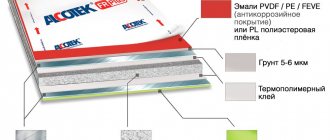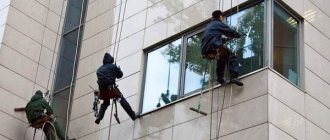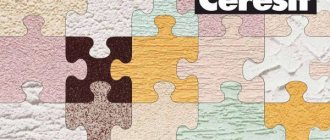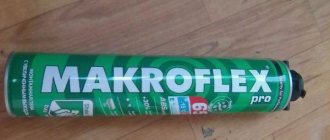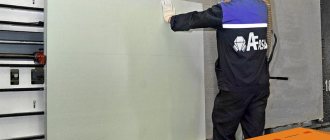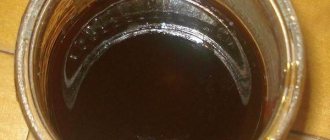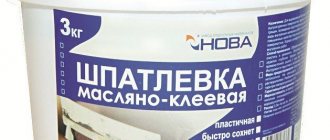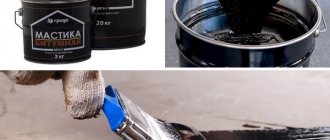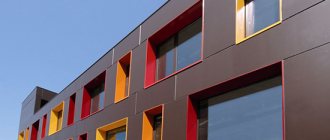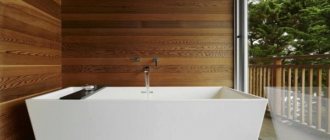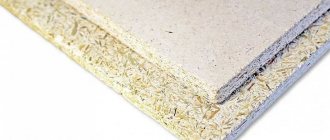When arranging ventilated facades, special attention is paid to cladding materials. The durability of the coating, the protection of the building from negative factors and, of course, the external attractiveness of the facade depend on them. The most popular are composite panels, which have a lot of remarkable properties. More recently, their scope of application was limited to public and industrial buildings, but now such panels are beginning to be used for finishing private houses.
Composite panels for facade
Application of Aluminum Composite Panels
Facade composite panels
Structure and characteristics of the composite
All layers of composite sheets are connected to each other using a special technology, creating a strong, reliable structure that is resistant to delamination.
The front surface can be painted in different colors, be monochromatic or have different patterns.
The panels are rectangular sheets with a metal or polymer base and a thermal insulation layer.
The inner layer is covered with an anti-corrosion coating. Marks in the form of arrows are applied to the back side of the panels, indicating the cutting direction when cutting sheets.
The outer face layer has decorative and protective layers of polyester or PVDF that protect the material from ultraviolet rays and adverse weather conditions. The front surface of the panels can be painted in different colors, have a wood or brick pattern, natural stone or decorative plaster, and be matte or glossy.
Aluminum, steel or synthetic sheets are used to give strength, rigidity and reinforcement to the panels.
The basis of the composite is a polymer filler, which is responsible for the technical properties of the material.
The multilayer structure is held together by a layer of adhesive or PVDF resin.
Fig.1. Structure of aluminum composite.
Composite panels can be used at temperatures from -50 to +80°C.
The material is not subject to corrosion, is resistant to aggressive natural influences, and is not affected by mold and microorganisms. Refers to low flammability.
According to fire safety standards, the material is allowed for use in the cladding of individual residential buildings and public buildings.
Useful tips
The material is easy to process, so there are no problems with cutting if everything is done correctly. First, you should only cut in the direction specified by the manufacturer. On the back of each panel this direction is indicated by arrows. Secondly, before cutting, you need to take accurate measurements and mark a line with a marker or chalk, and securely fix the panel itself on the table using clamps.
Aluminum is a soft, fusible metal, so you need to drill it carefully, at low speed - from 500 to 800 rpm. If you need to drill a large number of holes in aluminum panels at once, the drill must be periodically cooled with water.
An important condition: the drill must be very sharp; hand sharpening is not suitable here.
When bending panels, it is necessary to maintain an ideal cleanliness of the surface, since aluminum shavings or accidentally trapped grains of sand under pressure can leave scratches on the front layer, which cannot be removed. This will not only reduce the attractiveness of the cladding, but also reduce its resistance to precipitation and ultraviolet radiation.
An example of a ventilated façade lined with composite panels
Types of composite panels
On the construction market, composite panels are presented in several varieties, differing in composition and number of layers, sizes and color palette:
Aluminum
Consist of thin aluminum plates. They are characterized by high strength and rigidity with low weight. Aluminum panels are not afraid of wind loads. They cost more than their analogues. They can be installed on the facades of high-rise buildings and unstable load-bearing fencing, advertising and decorative structures.
Mineral
They contain foamed polyethylene and fire retardant compounds that reduce the flammability of the material. The material does not melt under the influence of open fire. During combustion, a small amount of smoke is released
Polymer
The basis of the material is polycarbonate. They are lightweight and affordable. They are inferior in strength, rigidity and load-bearing capacity to aluminum and mineral analogues. Used for interior decoration.
Durable and stable compounds are used as decorative and protective coatings:
- PVDF paints create a high-quality decorative layer that does not fade in the sun, does not deform in the cold and in hot climates. Does not retain dirt and dust. They do not lose their attractiveness until they are 25 years old.
- Laminating films can imitate natural materials such as wood, brick, stone and metal. They serve from 15 to 20 years. They are distinguished by a variety of patterns and colors, high quality finishes and a more expensive price than their analogues.
- Oxide coatings form a mirror-like, corrosion-resistant, durable coating on the surface that can serve without loss of quality for up to 20 years.
The color palette of composite panels includes more than 200 items according to the RAL catalogue, of which more than 17 are metallic shades.
Fig.2. Choice of shades of composite panels.
The best manufacturers
Since composite panels are not yet widely used, like siding or corrugated sheets, not many companies are engaged in their production. There are about 30 noteworthy manufacturers on the domestic market, whose products meet the necessary standards. Moreover, most of them are Russian and Chinese companies, as well as their joint ventures. But the leader is still the German-Swiss brand “Alukobond”, whose composite panels appeared in Russia earlier than others.
Alukobond
Alucobond - aluminum composite panels
Composite panels of this brand are characterized by a combination of high strength and flexibility, which allows easy installation on curved surfaces. They are produced in widths from 1 to 1.5 m, lengths from 3.20 to 8 m. The maximum weight of 1 m2 of cladding is 7.7 kg. The range of panel colors is very wide; there is a series of models with imitation stone and wood in various shades. The average service life of the material is about 50 years.
Goldstar
Composite panels "Goldstar"
The material is produced in Russia, has excellent quality, and fully meets accepted standards. In the manufacture of panels, polymer and mineral fillers are used, and the coating is PVDF. The range is very wide, a large selection of shades on the RAL scale. The manufacturer offers several spectacular series with imitation of various materials: “Vologda” - wood-effect panels, “Mirror” - imitation of a mirror surface, polished metal, gold and silver; “Palermo” is an imitation of natural stone. The Chameleon series panels, which change color from different viewing angles, are in high demand. The thickness of the material of this brand is 3-4 mm, width - 1.22, 1.25 and 1.5 m, length 2.44 and 4 m.
ALLUXE
Chinese-made composite panels are in no way inferior to domestic brands. The products are manufactured using the best Western technologies and have all the necessary quality certificates. The layer is a polymer and mineral filler, the coating is PVDF. The thickness of the panels is 3 and 4 mm, the standard width is 1.25 m, the maximum length is 5.70 m. The color palette of the panels includes 23 options, both with a glossy and matte effect.
Aluminum composite panels ALLUXE
Products of such brands as “WinBond”, “Alcotek”, “YARET”, “Dibond” are also popular. You need to purchase them only from official representatives, since there is a risk of buying a fake.
Alcotek
YARET composite panels of the Alucobond type
Prices for composite panels
Composite panels
Video - Manufacturing of Alucobond panels
Typical sizes
| Length, mm | Width, mm | Thickness, mm |
| 1500 | 4000 | From 2 to 6 |
| 1220 | 4000 | |
| 1500 | 6000 | |
| 1220 | 6000 |
Other panel sizes are possible upon individual order.
Advantages and disadvantages of panels
Composite panels, like any other cladding panels and materials, have their own characteristics.
The positive qualities of panels made of composite materials include the following indicators:
- moisture resistance;
- strength;
- resistance to external influences;
- plasticity of panels;
- soundproofing;
- ease of construction;
- ease of care;
- UV resistance;
- wide color range;
- the metal inside the panel does not corrode;
- ease of installation;
- durability.
Due to their qualities, composite panels can be used both in industrial construction and in the frequent design of facades.
The disadvantages of this type of facing material include the high cost of the coating compared to similar facing materials.
IMPORTANT!
Inexpensive types of composite panels may contain polymer or aluminum layers, which tend to deform at high temperatures.
Expensive types have fire protection , so if you choose composite panels, it is better not to save.
Advantages of panels
Composite materials are environmentally friendly and safe. They have good heat-protective qualities. They do not fade in the sun. They combine strength, rigidity and ductility.
Composite boards have high performance indicators:
- Lightness. The weight of one square meter of sheet is from three to eight kilograms, depending on the materials used. Composite panels are 3-4 times lighter than steel sheets of similar rigidity, and 1.5-2 times lighter than aluminum panels.
- Durability. Thanks to these indicators, cassettes are manufactured in large sizes, which allows installation work to be carried out in a short time with minimal labor costs.
- Resistant to temperature changes and aggressive environmental influences. Can be used in hot climates and extremely low temperatures.
- Reliability and durability. Finishing coatings made from composite panels can last up to 50 years without loss of quality and attractive appearance.
- Increased sound insulation. In combination with insulating layers and an air gap when installing ventilated facades, they can significantly increase the sound insulation of rooms and protect against street noise.
A wide range of colors and excellent flexibility allow you to create unique facade designs and interior interiors of buildings.
Ventilated facades can be hung on any walls without preliminary preparation, which significantly saves construction or repair costs.
Negative properties include low maintainability. If a composite sheet is damaged, it is almost impossible to repair it.
The risk of scratches on the cladding increases the requirements for installation, storage and transportation of the material.
Price list
Design work
| Name of works | Price from, rub. |
| Testing | For free |
| Geodetic survey of the structure | from 20 rub/m2 |
| Creation of working documentation for the installation of a ventilation façade | from 70 rub/m2 |
| Registration of a color passport | RUB 155,000 |
| Issue an OATI order | 10000 rub |
| Project development | 30,000 rub. |
| Development of a work project | 30,000 rub. |
| Creation and approval of TDR for the duration of repair work | 30,000 rub. |
Works
| Name | Price |
| Assembly of the vertical subsystem: | from 500 rub/m2 |
| — galvanized with polymer coating | 400 rub/m2 |
| - aluminum | 600 rub/m2 |
| - made of stainless steel | 800 rub/m2 |
| Assembly of the interfloor subsystem: | 500 rub/m2 |
| — galvanized with polymer coating | 480 RUR/m2 |
| - aluminum | 720 RUR/m2 |
| - made of stainless steel | 960 RUR/m2 |
| Horizontal-vertical subsystem: | 650 rub/m2 |
| — galvanized with polymer coating | 560 RUR/m2 |
| - aluminum | 840 RUR/m2 |
| - made of stainless steel | 1120 rub/m2 |
| Wall insulation in 1 layer | 200 rub/m2 |
| Wall insulation in 2 layers | 300 rub/m2 |
| — basalt heat-insulating slabs, density = 45 kg/m3, m3 | 1850 rub/m3 |
| — basalt slabs, density = 80 kg/m3 | 2750 rub/m3 |
| — penoplex, ground floor | 5020 rub/m3 |
| Installation of the protective membrane | 100 rub/m2 |
| - windproof membrane | 95 RUR/m2 |
| Fastening of facing material S, m2: | |
| S≥ 1 m2 | 600 rub/m2 |
| 1>S≥ 0.36 m2 | 720 RUR/m2 |
| 0.36>S>0.1 m2 | 900 rub/m2 |
| S≤0.1 m2 | 4200 rub/m2 |
| Cladding material: | |
| - aluminum composite panels | 1155 RUR/m2 |
| Installation work: | |
| Construction of a subsystem for a parapet cover | 500 rub/m. |
| — galvanized with polymer coating | 320 rub/m. |
| - aluminum | 480 rub/m. |
| - made of stainless steel | 640 rub/m. |
| Assembly of additional elements: | 350 rub/m2 |
| - metal | 277 RUR/m2 |
| - aluminum-composite | 288 RUR/m2 |
| - aluminum | 550 rub/m2 |
Application area
One of the most common areas of use of composite sheets is the installation of suspended ventilated facades.
Composite sheets have gained wide popularity in the construction and reconstruction of buildings.
Fig.3. The use of composites in the construction of non-standard objects.
Composite sheets are used to create various structures and structures:
- finishing of loggias and balconies, installation of canopies and cornices;
- production of signs, information and exhibition stands, outdoor advertising structures;
- creation of steles, signs, small architectural forms in urban design;
- decoration of walls, columns, ceilings, inside buildings;
- installation of office partitions and special furniture;
- lining of refrigeration chambers and automobile refrigerators;
- construction of gas stations, kiosks, bus stop pavilions and other non-standard objects.
Composite sheets are widely used in building design. Easily imitate bricks and natural stones, mirrors and metal.
Rice. 4. Facade of a shopping center made of composite cassettes.
Composite cassettes are not recommended for installation in preschool and educational institutions and hospitals.
How to install
See also
Kraspan facade systems: product descriptions, reviews from builders
Nowadays production is carried out by many companies. At the same time, there are also leaders who produce the best, according to consumers, composite panels for facades.
As for installation, these façade products are mounted according to the same scheme as almost any ventilated façade.
In practice, the process looks like this:
- prepare the walls by removing everything unnecessary;
- install brackets for the sheathing;
- lay a layer of thermal insulation material;
- fix the vapor barrier layer;
- fasten the sheathing elements to the brackets;
- Install the panels themselves onto the sheathing.
If anyone is interested, I will describe in detail the installation of composites in a separate material. From the very beginning to the finish.
Features of choice
For self-assembly of composite structures, it is worth purchasing the material complete with brackets, guide profiles, fasteners and other accessories.
The reliability of installation and the service life of structures depend on the quality of the panels.
When choosing composite panels, you should be guided by the following recommendations:
- The inside of the panel must contain information about the production date, batch number, indicate the production code and type of panel.
- Any batch of composite is completed with technical documentation confirming the quality and fire resistance of the material.
- Upon receipt of the goods, check the panels for the integrity of the protective film, the absence of defects, dents and scratches. It is important to remember that panels with a high degree of flammability cannot be used in the construction of residential buildings and public buildings.
The protective film indicates the direction of placement of the composite sheets on the facade in order to avoid different colors during installation.
Fig.5. Marking of material on protective film.
Advantages and disadvantages
Composite panels have significant advantages:
- resistance to corrosion;
- high strength;
- resistance to dynamic loads;
- good flexibility;
- small weight;
- attractive appearance, since sheets are produced in different colors and textures, and often imitate wood, natural stone or other materials;
- it is allowed to carry out finishing inside residential or commercial buildings;
- long service life;
- resistance to temperature changes, precipitation, ultraviolet radiation or frost;
- suitable for buildings built from different materials, therefore they are used not only for residential premises, but also for commercial or industrial facilities;
- low weight allows you to create a ventilated façade on a building with a light foundation;
- improvement of soundproofing and thermal insulation parameters;
- compliance with fire safety requirements;
- environmental Safety;
- vibration absorption;
- ease of repair;
- no expansion when the temperature rises excessively.
But the material has some disadvantages. Installation must be carried out by professionals who act with extreme caution, since the outer decorative layer is easily damaged. The cost of such a facade is considered high.
Installation technology for hinged ventilated facades
Curtain ventilated facades are very popular when finishing not only public buildings, but also modern private houses.
They are installed using modern technologies and are suitable for walls made of brick and aerated concrete, reinforced concrete panels and wood.
The ventilation façade design includes:
- cladding made of composite cassettes;
- steel subsystem;
- insulating, vapor barrier and windproof materials.
An air gap is created between the insulation and the facing layer.
Thanks to the air gap, which operates on the principle of an exhaust pipe, the moisture condensing under the façade cladding is drawn out with the ascending air flow into the atmosphere.
In addition, the layer of air is an additional heat insulator. It smoothes out thermal deformations that occur during temperature changes, thereby preventing premature destruction of load-bearing and enclosing structures.
You can use frosted glass or darker colors. Polycarbonate is available for sale in a wide range of colors: opal, bronze, turquoise, blue, orange.
You might be interested in:
| Composite panels | Dimensions | Sheet cost |
| ALTEC mirror gold (RAL 0007) al 0.21 | 1500x4000x3 | 10352 rub. |
| ALTEC graphite metallic (RAL 0009) al 0.21 | 1500x4000x3 | 4500 rub. |
| ALTEC champagne metallic (RAL 0004) al 0.21 | 1500x4000x3 | 4500 rub. |
| ALTEC bronze metallic (RAL 0002) al 0.21 | 1500x4000x3 | 4500 rub. |
| ALTEC gold metallic (RAL 0003) al 0.21 | 1500x4000x3 | 4500 rub. |
| ALTEC mirror gold (RAL 0007) al 0.3 | 1220x4000x3 | 9760 RUR |
| ALTEC mirror silver (RAL 0007) al 0.3 | 1220x4000x3 | 9760 RUR |
| ALTEC graphite metallic (RAL 0009) al 0.3 | 1220x4000x3 | 5002 rub. |
| ALTEC champagne metallic (RAL 0004) al 0.3 | 1220x4000x3 | 5002 rub. |
| ALTEC bronze metallic (RAL 0002) al 0.3 | 1220x4000x3 | 5002 rub. |
The entire range >>>
The installation of suspended ventilated facades is carried out in a certain sequence:
- The vertical marking of the facade is carried out using a laser tape measure, measuring strips and a tape measure. The marked points are connected by horizontal and vertical lines using paint cord.
- In the place where the brackets are attached, holes are drilled and anchor dowels are inserted.
- Brackets are mounted, consisting of a fixed load-bearing element and an adjustable movable insert, which is secured using plumb lines at the desired level. The pitch of the brackets should be 40-55 centimeters vertically. The horizontal spacing of the guides must be set based on the dimensions of the composite cassettes.
- Mineral wool, penoplex or expanded polystyrene slabs are installed on the frame brackets. In the place where the insulation is hung on the bracket extension, crosswise cuts are made in the slab. The insulation in the center and in the corners is fixed to the wall with glue.
- A steam and windproof facade membrane is laid on top of the insulation with an overlap of 10-15 centimeters between the panels. All layers are attached to the wall with disc-shaped dowels.
- To install composite panels, U-shaped vertical guides are attached to the brackets with screws or rivets. Spacer plates are inserted into the profile cavity to serve as a hook for façade cassettes. It is important to ensure reliable and rigid fastening of all frame elements strictly in one plane.
- Hanging the cassettes should begin from the bottom of the sheathing, aligning the panels strictly horizontally and fixing them in the upper corners with self-tapping screws. The following sheets are attached in the same way, maintaining the same gaps of 10-12 millimeters.
To isolate the metal from the wall, thermal break gaskets made of insulating material are installed under each bracket.
Rice. 6. Mounting unit for a suspended ventilated facade.
What it is
Before you buy and install composite panels for the facade, you need to understand what kind of structures they are.
A composite is the combination of several materials into a single whole structure. This allows for improved technical characteristics. The panel is superior to every single material that makes up the composite.
All composites have a plastic base. She's the matrix. And also a filler. It performs the functions of a reinforcing layer.
Nowadays you can find terracotta panels and various types of thermal panels for external cladding on sale. Even Japanese panels are very popular in Russia.
What about composite products? Let's figure it out.
The structure here is complex, since the composition also includes metal plates, as well as additional protective and decorative layers. Each manufacturer such as Bildex, Alumatrix or Goldstar can produce products with different fillers, number of layers or type of coating. But they all have common points in common. This is a small mass with high levels of rigidity and strength. They are not afraid of external factors, and also last a very long time.
Externally, it is a thin metal plate on which there is a heat-insulating layer. The paint and varnish composition is applied to the front side. More expensive analogues have a laminated coating, which allows them to imitate the structure and texture of natural and artificial materials.
Making cassettes
To install composite facades, cassettes are pre-made in accordance with design drawings.
To do this, corners are formed on four sides of the composite sheet using milling and bending machines.
Rice. 7. Scheme of workpiece development and finished composite cassette.
When forming corners, a layer of composite is cut out on a milling machine in the form of 90° or 135° angles or a rectangle 14 mm wide, leaving a layer of polyethylene with a thickness of 0.5 to 1.5 mm at the bending point.
Rice. 8. Scheme of options for bending composite sheets.
Expert advice on processing and installation
Sawing of composite panels is carried out using milling equipment. If the volume of work is large, then it must be stationary, otherwise you can get by with a hand tool, for example, a circular saw or a milling cutter. During processing, the sheets are clamped using clamps. You will definitely need gaskets made of wood or polymer. They will protect the cladding from the formation of dents.
When cutting panels, you need to consider the following nuances:
- for aluminum cassettes, it is allowed to use standard jigsaws, the cutting speed is no more than 5000 rpm;
- for milling materials, you need to use cutters made of hard metal alloys (5000 rpm) or high-speed steel (3000 rpm);
- the depth of milling depends on the total thickness of the outer aluminum sheet; when bending corner elements, the thickness of the layer left during cutting cannot be less than 0.6 mm if the sheet is 0.5 mm (0.4 for sheets 0.3 mm);
- for the production of rectangular grooves 1-1.2 mm (sheet 0.3) and 1.3-1.6 (for 0.5).
It is important to know!
The cutters have 3 types of cutting edges for each type of groove. For corners of 90 and 135 degrees, for rectangular ones.
Drilling and bending
The panels are drilled with a twist drill for metal. It must be made of high-speed steel. To speed up the work, choose drills with a tip angle from 100 to 140 degrees.
Aluminum panels bend easily. This does not require specific equipment. An edging press or bending machine is quite suitable. To reduce the risk of damage to the panels to zero, their outer surface is protected with foil or plastic (polyethylene) sheets 2 mm thick.
The permissible bending radius must be at least 15 times the thickness of the sheet. The distance from the edge of the sheet to the location of the bend is also important. The indentation is at least 5 material thicknesses. The desired shape will be obtained by edging milling. That is, the panel bends after milling. Since the thickness of the remaining material is insignificant, you can give the desired shape manually. The work is carried out permanently at the site.
Advantages of facades made of composite panels
Ventilated curtain facades made of composite cassettes are very popular due to significant advantages over other finishing options:
- do not require preliminary leveling of the walls;
- provide protection for load-bearing enclosing structures from cold and heat, direct sunlight, rain and wind;
- capable of insulating and increasing noise insulation of buildings;
- the light weight of the hanging system does not require additional strengthening of the supporting structures.
Ventilated facades eliminate dirty finishing processes and allow structures to be installed in a short time, regardless of the time of year and weather.
Rice. 9. Installation of cassettes made of composite sheets.
By strictly observing the sequence and technology of work, you can create a reliable and beautiful coating, give the facade a unique, bright and modern appearance, increase sound insulation, and achieve tangible energy savings in the building.
Construction device
The ventilation façade has a simple and understandable design. The main goal is to obtain a strong and reliable cladding using lightweight materials.
The construction of the facade involves the use of the following layers:
- a rigid frame, parts of which are attached to the walls of the building, and for this purpose metal profiles are used, fixed with brackets;
- thermal insulation and waterproofing materials that make it possible to protect the structure from cold and moisture;
- panels attached to the frame using hidden fastenings, resulting in a beautiful, smooth finish.
Each layer in the structure has its own purpose. Waterproofing prevents moisture from entering the walls, which can harm the material.
Typology
Products are divided into types according to the composition of the filler and the method of external coating.
The following types of slabs can be found on sale:
- Mineral. The manufacturing technology involves the inclusion of foamed polyethylene with the addition of various flame retardant substances. The products belong to the category of slightly flammable materials. You can buy such materials in Moscow in construction stores or order directly from the manufacturer.
- Polymer. Includes polycarbonate and polyethylene foam. Thanks to the components it is light in weight. It is used for cladding a variety of buildings with low load-bearing capacity. Area of application: interior design of premises.
- Made from stainless steel. Stainless steel material fully complies with the flammability class, is affordable, and harmoniously combines with other home finishing options. Stainless steel cassettes are widely used to create ventilated facade structures. Finding steel cassettes for sale in Moscow is not difficult. Steel panels are also available in square or rectangular shapes.
The third type, which has a lot of advantages, is aluminum cassettes; we will consider it separately.
How to choose an anchor
The anchor is selected using special tests - anchor pullout tests. Those. A representative of your chosen anchor manufacturer arrives at the site. Installs 15 pieces of each type of anchors in the wall of the object and pulls them with a special device. The device shows the maximum load on the anchor. The ultimate load is the one at which the block breaks and the anchor falls out of the wall. A test report is drawn up.
But this is not enough. We don’t even want to admit the thought of a possible anchor falling out of the wall of an already installed façade, do we? Therefore, using special formulas, multiplying the maximum load by the safety factor for the parts, the manufacturer obtains a certain value. This value is the permissible maximum load on the anchor. The manufacturer issues a pull-out test report for the anchor; it reflects the permissible load. For example, the anchor holds a maximum of 180kg.
Then the manufacturer of the curtain facade subsystem performs a static calculation of the loads on the façade and the deformations of the structure. The static calculation contains all the necessary data: wind region, cladding weight, profile spacing, bracket spacing, cladding offset, bracket heel area and many other different values, many complex formulas, but, most importantly, the value of the load that the system transmits to one attachment point. One mounting point - one bracket. In general, this value is given in Newtons, but for ease of perception, we will give an example in kg. For example, this value is: 1200N, which is very approximately 120kg.
How can we understand whether the anchor that we tested earlier is suitable for this object? It is necessary to compare two values: the maximum ultimate load from the anchor pullout test report and the value obtained from the Static Load Calculation. Those. in our case: the anchor holds 180 kg, and the system transfers 120 kg of load to the anchor. So the anchor is holding. Can be used. Let's look at the example in reverse: the anchor holds 120 kg, and the system transmits 180 kg. This means you need to change the anchor or increase the number of attachment points - brackets.
The bracket must be fixed to the wall through a thermal bridge - a special gasket. This will avoid cold bridges and keep the house warm. It does not support combustion and is not expensive - there is no need to “save on matches.”
In conclusion, we inform you that the installation of cassettes begins from the bottom row. Each row must be laid level, starting from the zero point of the facade. Replacing a deformed cassette unit is complicated by the need to dismantle the entire row of panels.
Frameless ventilation facade
Just as not every curtained façade is ventilated, not every ventilated façade is curtained; there is also a frameless variety. We are talking about a brick ventilated facade - a house made of any wall material is insulated with non-combustible thermal insulation and covered with facing brick through the ventilation gap, fixed with flexible connections or metal brackets. A brick ventilated facade is erected in two ways:
- at the stage of building the box - when pouring, the foundation is made taking into account the thickness of the multi-layer wall;
- around the house in use - if it is not possible to support a brick screen on the foundation, an additional cast is cast for it, less often it is supported on metal subsystems.
Production technology
The products are a tape that is not interrupted. They can have different lengths. The manufacturing technology is not complicated. First, the aluminum sheets are thoroughly cleaned and coated, followed by lamination.
At the last stage, the cassettes are milled. They are placed on the walls to create a ventilated façade.
Installation of a ventilation façade made of composite
Our company offers customers prompt and qualified installation of ventilated composite facades at attractive prices. Strict adherence to legal regulations in the field of installation work, the use of exclusively certified materials and the provision of a long-term guarantee for the work performed help us gain the trust of a huge number of clients. Our team consists of experienced specialists from Russia who have all the necessary skills and knowledge for cladding building facades. As a member of the SRO, our company maintains a reputation as a trusted partner, and we work with both corporate and private customers. By concluding a service agreement with us, you can count on fast and competent installation of ventilated facades, since we have the best craftsmen and a full range of necessary tools.
| Average installation calculation (price of work per 1 sq.m. of facade) | |
| Material | Price |
| subsystem | 400 |
| insulation 50 mm | 150 |
| composite | 1110 |
| the fasteners will be insulated. | 50 |
| subsystem fasteners* | 80 |
| slopes, ebbs** | 250 |
| TOTAL | 2050 |
Free services: Surveyor's visit, preliminary calculation of the facade, design development, provision of cladding samples
| Average calculation of materials (price of work per 1 sq.m. of facade) | |
| Job | Price |
| subsystem | 530 |
| insulation 50 mm | 220 |
| porcelain stoneware | 520 |
| slopes, ebbs** | 165 |
| parapet | 280 |
| milling | 250 |
| assembly | 100 |
| TOTAL | 2065 |
| Turnkey calculation (Work + Material) | |
| Price | |
| TOTAL | 4120 |
Note: *Dowel in concrete, brick, stainless steel rivets **The price is average, can vary from 0 to 350 rubles.
| Prices for additional work on facade cladding. Prices per sq.m. | |
| Type of work | Price |
| Installation of insulation with a membrane | for free |
| Slopes, ebbs (framing of window openings) | negotiable (based on volume) |
| Scaffolding rental | negotiable (based on volume) |
| Facade design | 80,000 rub. (Full construction) |
Construction of houses
0 votes
+
Vote for!
—
Vote against!
More than 30 companies present aluminum composite panels on the market. Products from all manufacturers have essentially the same technical characteristics. The general name alucobond is used for this building material. The word Alucobond is a brand of a Swiss manufacturer that first introduced composite panels to the domestic market. Sometimes the slabs are called sandwich panels, due to their structural features (multi-layering). This article will focus on alucobond panels.
- ALUCOBOND (Switzerland)
Alucobond panels are widely used by companies involved in construction and finishing work. This material allows you to transform the exterior of a building, giving architects and builders endless possibilities not only for designing the facade, but also the interior space.
Alucobond photo
Alucobond characteristics
The panels consist of several layers. Between sheets of high-strength aluminum there is a filler made of synthetic polymer or high-density polyethylene foam.
- The side of the panel facing the inside of the building is treated with an anti-corrosion coating. The front surface is covered with a layer of polyester (PE) or fluorinated carbon (PVDF) in various shades.
- Polyester paint provides a durable coating with a glossy surface. Products painted with this material can be used in almost any climatic conditions.
- PVDF coating is characterized by increased color fastness (practically does not fade) and higher resistance to aggressive environments. Due to their improved characteristics, the panels are used for façade cladding in regions with the most severe weather conditions, including coastal areas.
- For ease of installation and protection of the front surface, the painted side is protected with a laminated film, which is removed after completion of work.
- The rigid and durable design of alucobond panels allows them to be used for cladding high-rise buildings using ventilated facade technology. This system ensures air circulation, thereby facilitating the removal of condensate.
- On a perfectly flat and smooth surface, cracks do not appear when bending and shaping the material. These properties are acquired thanks to a very durable coating. Alucobond can be used in the most severe climatic conditions.
- In production, a continuous strip of composite material is cut into pieces of standard length. Formed cassette slabs are also produced, which are completely ready for installation.
- The panels are available in various colors with a matte finish or a metallic sheen. The widest selection of shades and sizes allows developers and designers to use alucobond for various purposes.
Scope of application of alucobond composite panels
Due to the excellent characteristics of the material, its scope of application is almost limitless. Composite panels are used:
- in the arrangement of facades of any number of storeys, giving buildings a progressive look;
- when reconstructing old buildings in order to update the exterior, improve the soundproofing and thermal insulation characteristics of the walls;
- for cladding architectural elements: balconies, canopies, columns, etc.
- in the design of billboards and signs, light boxes and supports;
- for the manufacture of decorative room partitions, interior finishing materials;
- in the automotive industry, they are used to make trim elements for cars, buses, and car bodies;
- in the production of casings, housings, boxes for various equipment.
Plates made from composites cope perfectly with the functions assigned to them. They are not afraid of exposure to adverse climatic conditions and allow construction and installation teams to bend them to the required degree.
This type of material is widely used for external and internal work for any purpose. It allows you to create real masterpieces, both when arranging the exterior of a building and the interior of premises.
Advantages and disadvantages of alucobond
The advantages of this building material include:
- Durability. Manufacturers provide a warranty on panels from 15 to 25 years. This means that the exterior cladding can last more than 50 years without the need for repair or replacement of areas. The quality of the external coating will retain the attractive appearance of the facade even after decades.
- Simple processing. Composite panels can be cut, angular and radius bending, rolling, and welding polymer layers. The corresponding manipulations are performed using conventional wood and metalworking equipment or hand tools.
- Strength and elasticity. Steel sheets give the slabs the necessary strength and resistance to mechanical loads. Meanwhile, the material has flexibility, which allows it to take almost any shape.
- Weather resistance. The high-strength coating withstands harsh weather conditions, so composite panels can be used in extreme temperatures. Special formulations provide protection against corrosion caused by acid, salt and alkaline solutions.
- Aesthetics. A wide range of colors allows you to embody the bold ideas of architects and designers. The material can “imitate” plaster, marble, chrome, gold, etc. The durable coating will not fade under the influence of ultraviolet rays even after several decades.
- Thermal and sound insulation. The multilayer structure increases the soundproofing characteristics of the building. Thus, the sound absorption coefficient of a 4 mm thick panel is 25 dB. Such qualities are especially important for buildings located on busy streets. As for thermal insulation, the filler is largely responsible for this property. The polyethylene layer provides thermal insulation equal to 0.01 W/mK.
- Simplicity and cost-effectiveness of installation. The light weight of the panels does not increase the load on the foundation, and their high strength makes it possible not to use additional reinforcing elements. The simplified design of the frame for the ventilation facade makes work easier and saves the budget.
Flaws
- A negative point is low fire resistance . Although this indicator is determined depending on the type of filler. The polymer layer weakly resists fire and releases toxic substances when burned. The mineral layer, made mostly of foamed polyethylene, is treated with fire retardants, which allows such panels to be classified as low-flammable. According to international standards, such products are marked FR.
Today on the market there are panels with an improved “filling”, which includes aluminum hydroxide. This substance resists exposure to open flame for 2 hours. But the price of these alucobond panels is significantly higher, so their use is not so popular.
- It is worth noting the complicated repair work . When replacing a damaged panel, sometimes it is necessary to remove several adjacent ones.
Tool for working with alucobond
When installing ventilated facades made of composite panels, you need a tool that will be used to adjust the cassettes to certain sizes. The most common solutions are milling by:
- vertical manual router;
- CNC machine;
- disk milling machine.
Each method has both advantages and disadvantages. I would especially like to note that the cutting accuracy determines the service life of the facade. Poor quality milling leads to the formation of cracks in panels due to temperature changes.
- Manual frezer . This method is popular due to its mobility and low cost of equipment. This is where all the advantages end. But there are quite a few disadvantages: low performance. The milling speed is significantly lower compared to other methods of processing composite panels;
- complexity. The work requires certain knowledge and skills. The tool requires preliminary settings;
- low quality. A finger cutter leaves burrs on the material, as well as a large number of polymer shavings, which makes bending the panels difficult;
- unreliability. It is impossible to achieve high accuracy down to tenths with such equipment. In addition, the tool will quickly fail after processing a certain volume of composite (≈ 80 m²).
- simple operation. There is no need to carry out any setup operations;
It is worth noting that the listed advantages do not apply to disc milling cutters of non-original origin. This technique is used for small-volume work subject to certain conditions. Accordingly, the warranty period and cost of equipment vary greatly.
Ventilated facade made of alucobond panels
- Their advantage lies in the ability to carry out relevant work in a short time and under almost any climatic conditions. A ventilated facade will ensure the protection of buildings and the durability of the facade.
- A special profile system allows air flows to circulate freely between the building wall and the finishing material. Due to this, water vapor formed during the operation of the building is not retained, but evaporates naturally.
- Insulation allows you to reduce heat transfer from walls, thereby minimizing heating costs. At the same time, the thermal insulation layer makes it possible to reduce the thickness of the load-bearing walls, and therefore reduce the load on the foundation.
- The facade panel protects the walls of the building from the effects of adverse environmental influences. In addition, it improves the exterior and gives a modern look to buildings that previously needed major repairs.
Alucobond panel installation technology
Carrying out installation work is not difficult. Here you need to know several basic provisions and have experience in construction. The technology is as follows: a frame consisting of a load-bearing profile and a bracket is attached to the external walls. Later, the structure is covered with facade panels. The use of thermal break gaskets will help significantly reduce the loss of thermal energy.
Stages of work:
- After marking, brackets are attached to the wall to which the guide profiles will be fixed. The brackets themselves are fastened using expansion dowels (anchor bolts);
- A layer of insulation of a given thickness is mounted to the wall surface using glue and disc dowels. The thermal insulation material must have a hydro- and windproof membrane on the front side. The use of plastic film is prohibited;
- the guides are fixed to the installed brackets using special fasteners;
- Next, the installation of decorative panels is carried out.
Alucobond video
What you need to know when working with alucobond
Design
When developing a system of ventilated facades, it is necessary to know and take into account a number of indicators:
- weight and size of composite panels;
- façade height;
- characteristics of supporting elements;
- wind load;
- corrosion resistance. The supporting structure must be able to withstand exposure to aggressive environments.
Support frame
The strength of the structure under the curtain wall is calculated taking into account the following parameters:
- it must withstand the weight of the agricultural sector, wind loads, shrinkage of the structure, and thermal expansion;
- make it possible to correct the geometry of the structure (wall unevenness) as much as possible;
- securely and firmly fixed to the surfaces of load-bearing walls;
- withstand adverse effects of climatic conditions without damaging the frame;
- comply with all applicable rules and regulations;
- solve architectural concepts when working with both new buildings and previously constructed buildings.
Metal parts, including guides, can be made of galvanized metal, aluminum or stainless steel. Of course, the technical parameters of the materials are different, as is the actual cost. The choice should be made in the direction of strength and quality, and not economy.
Layers of the cake
High performance in terms of vibration, heat and noise insulation properties can only be achieved by following the technology. In cross-section, the ventilated facade looks like this:
- sand-cement plaster with a thickness of at least 1.5 cm on the inside of the wall;
- wall made of foam, gas block or expanded clay concrete. If sand-lime brick is used, the thickness of the masonry should be 380 cm;
- insulation – mineral wool pressed into slabs, 10-20 cm thick;
- windproof film with a vapor-permeable effect;
- composite panels 4 mm.
The main stages of work with alucobond panels
- Before starting work, drains and antennas are removed from the external walls, and air conditioning units are dismantled. Peeled paint and plaster are removed from the surface. Next, a point is selected from which all subsequent markings will go.
- All points necessary for fastening are marked and working holes for dowels are drilled. The brackets are fixed with anchors, where an aluminum washer ensures fastening strength. As a rule, the step between the brackets is 60-75 cm, that is, 4 pieces per 3 m.
- The insulation boards are first placed on a special glue; for greater reliability, they are secured using umbrella dowels. Thermal insulating material is also placed between the brackets, after making a cut in the right places. Mineral slabs are covered with a windproof membrane.
- Vertical guides are attached to the brackets using rivets or self-tapping screws. The ventilated gap should not be less than 40 mm; we are talking about the distance between the insulation and the upper surface of the guide.
- Horizontal ones are attached to the vertical guides, where the step must correspond to the size of the cladding. It is worth noting that it is quite acceptable to first install the profile horizontally and then vertically.
- Composite panels are attached to the guides from the bottom up, fixation is done with screws or rivets. It is important here to ensure that there are no foreign particles (inclusions) in the gap during installation.
- During the work, the location of both vertical and horizontal profiles must be checked. Geometric mismatch will lead to distortion of the entire facade.
Composite Panel Manufacturers
Although this material is widely represented on the modern market, only 4 companies have gained great popularity. Manufacturers offer a range of panels made from high-quality composites.
ALUCOBOND (Switzerland)
- This is the first company that introduced the domestic consumer to a new building material. Thanks to which the factory brand has become a household name, today all panels are called alucobond, regardless of the manufacturer.
- Automatic transmissions have been produced under this brand for almost half a century, which from the very beginning and still holds the bar for the quality of its products. Today the concern's factories are located in Germany, the USA and Singapore.
- In addition to unsurpassed quality, the panels are distinguished by a wide color palette. Thanks to the tireless developments of technologists, it was possible to achieve the production of panels with shiny surfaces that imitate various natural materials.
The products are offered with 2 types of filler (polyethylene and mineral). The panels are also classified according to the type of flammability:
- flammability group G4;
- flammability group G1;
- flammability group G1, but with higher resistance to flame.
REYNOBOND (transnational corporation)
- European origin also indicates corresponding quality. Factories are located in the USA and France. Composite panels have high rigidity, and their physical and mechanical properties ensure the reliability and durability of the facades.
- The products are painted in standard colors, but Chameleon coating is also offered. The length of the panels can reach 6.5 m, which in turn allows you to reduce waste from cutting, thereby optimizing the costs of the budget.
The consumer is offered 2 modifications of this building material:
- with polyethylene filling Pe (not fire-resistant material);
- with mineral filler Fr (fire-resistant option).
DIBOND (Germany)
- Multilayer panels are produced in Germany using modern technology. German quality speaks for itself. Thanks to its high technical characteristics, the products of this manufacturer are in the top 5.
- The improved properties of the material significantly expand its use and make it possible to expand the scope when developing projects. The correct shape and rigidity of the agro-industrial complex greatly simplifies installation work
- In addition to solid colors, the decor line includes panels with glossy surfaces, chrome, gold, silver, and bronze finishes. The originality of colors and textures will allow you to implement non-standard solutions for finishing work on the facade, as well as to implement a progressive idea in the interior spaces.
ALPOLIC (Japan)
- The well-known Mitsubishi Group corporation has been producing composite panels for 44 years. Products are presented here in 2 types: low-flammable and fire-resistant version of class A2. Such high performance was achieved by using filler made from mineralized and highly mineralized materials.
- The concern's factories are located in Japan and the USA, additional warehouses are organized in Turkey and Holland.
- A special feature of the automatic transmission is the use of wear-resistant coatings for the front sides. In addition to resistance to aggressive influences, the coating also has excellent decorative properties.
- The manufacturer confirms the high quality of its products by providing a 20-year warranty. The actual service life of the panels, even in harsh conditions, is at least half a century.
One cannot help but mention the appearance of Chinese and Korean-made automatic transmissions on the market. Oddly enough, panels of this origin are not much inferior to products from famous factories. But the difference in price for products with similar characteristics is quite significant. Among the companies we can note GOLDSTAR (China) and NTV (a joint German-Chinese plant) .
Manufacturers have managed to combine the advantages of old materials and the improved properties of modern developments in composite panels. The latest technologies make it possible to quickly give facades an aesthetic appearance, while at the same time improving the heat and sound insulation properties of the building.
General information
The concept of “hinged ventilated facade” appeared in Germany. The structure consists of a protective and decorative coating, a sub-cladding frame and a heat-insulating layer, which are attached to load-bearing walls with an air gap between the cladding and the insulation. Thermal insulation is installed to further insulate the building.
Ventilated facades even out temperature fluctuations of external walls and reduce their deformation, which is especially undesirable in large-panel housing construction. External thermal insulation significantly increases the thermal insulation capabilities of the wall mass and reduces the cost of its repair.
Due to the pressure difference, the air gap acts like an exhaust pipe. As a result, moisture that condenses under the façade covering is removed from the enclosing structure into the atmosphere. In addition, heat loss is reduced, since the air in the gap is approximately three degrees higher than the outside air.
A specially developed installation scheme for a ventilated façade absorbs thermal deformations that occur during seasonal and daily temperature changes. Internal stresses in the supporting structure and facing material are reduced, which can destroy them.
Read our article “Calculation and selection of materials for a suspended ventilated facade.”
Ventilated façade.
